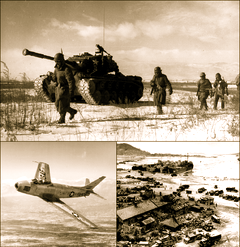Korean War


The Korean War was a war of firsts: The first jet war; the first war where it was not possible to unleash full power, politically or militarily; and the first battlefield of the Cold War. In this episode, we’ll watch a freezing, shattered U.N. army fight its way out of a Chinese trap in the longest retreat in U.S. history.

The Korean War was a war of firsts: The first jet war; the first war where it was not possible to unleash full power, politically or militarily; and the first battlefield of the Cold War. In this episode, we’ll watch a freezing, shattered U.N. army fight its way out of a Chinese trap in the longest retreat in U.S. history.
The Korean War (Korean: 한국전쟁 or 조선전쟁, Hanja: 韓國戰爭 or 朝鮮戰爭; 25 June 1950 – 27 July 1953) was a war between the Republic of Korea(supported primarily by the United States of America, with contributions from allied nations under the aegis of the United Nations) and the Democratic People’s Republic of Korea (supported by the People’s Republic of China, with military and material aid from the Union of Soviet Socialist Republics). The Korean War was primarily the result of the political division of Korea by an agreement of the victorious Allies at the conclusion of the Pacific War at the end of World War II. The Korean Peninsula was ruled by the Empire of Japanfrom 1910 until the end of World War II. Following the surrender of the Empire of Japan in September 1945, American administrators divided the peninsula along the 38th parallel, with U.S. military forces occupying the southern half and Soviet military forces occupying the northern half.
The failure to hold free elections throughout the Korean Peninsula in 1948 deepened the division between the two sides; the North established a communist government, while the South established a capitalist one. The 38th parallel increasingly became a political border between the two Korean states. Although reunification negotiations continued in the months preceding the war, tension intensified. Cross-border skirmishes and raids at the 38th Parallel persisted. The situation escalated into open warfare when North Korean forces invaded South Korea on 25 June 1950. It was the first significant armed conflict of the Cold War. In 1950 the Soviet Union boycotted the United Nations security council, in protest at representation of China by the Kuomintang / Republic of China government, which had taken refuge in Taiwan following defeat in the Chinese Civil War. In the absence of a dissenting voice from the Soviet Union, who could have vetoed it, the United States and other countries passed a security council resolution authorizing military intervention in Korea.
The United States of America provided 88% of the 341,000 international soldiers which aided South Korean forces in repelling the invasion, with twenty other countries of the United Nations offering assistance. Suffering severe casualties, within two months the defenders were pushed back to a small area in the south of the Korean Peninsula, known as the Pusan perimeter. A rapid U.N. counter-offensive then drove the North Koreans past the 38th Parallel and almost to the Yalu River, when the People’s Republic of China (PRC) entered the war on the side of North Korea. Chinese intervention forced the Southern-allied forces to retreat behind the 38th Parallel. While not directly committing forces to the conflict, the Soviet Union provided material aid to both the North Korean and Chinese armies. The active stage of the war ended on 27 July 1953, when the armistice agreement was signed. The agreement restored the border between the Koreas near the 38th Parallel and created the Korean Demilitarized Zone (DMZ), a 2.5-mile (4.0 km)-wide fortified buffer zone between the two Korean nations. Minor outbreaks of fighting continue to the present day.
With both North Korea and South Korea sponsored by external powers, the Korean War was a proxy war. From a military science perspective, it combined strategies and tactics of World War I and World War II: it began with a mobile campaign of swift infantry attacks followed by air bombing raids, but became a static trench war by July 1951.

